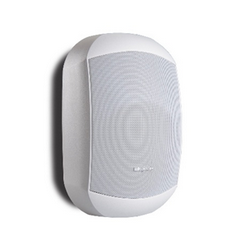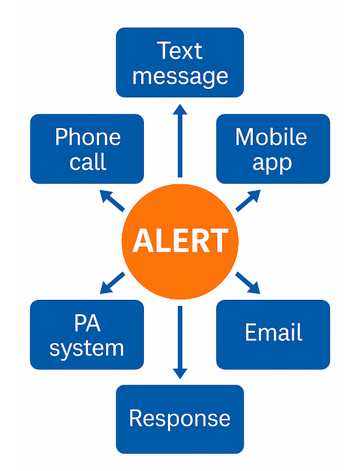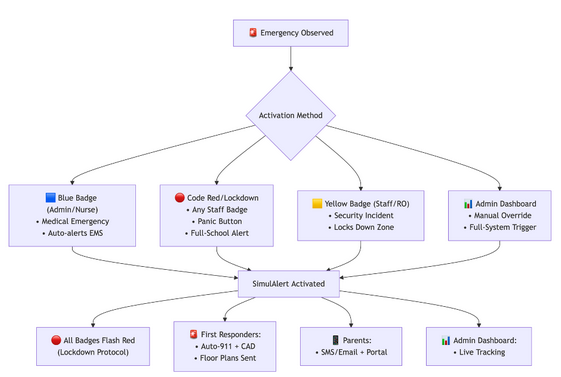Resources

School Safety Guide: How to Choose the Right Emergency Alert System for Your Campus
Introduction
In today’s rapidly changing world, the safety of students remains a top priority for schools (SchoolSafety.gov). With the rise of potential threats, both natural and man-made, implementing effective emergency alert systems has never been more critical. These systems not only enhance communication during crises but also empower educators, parents, and students to respond swiftly and effectively.

Figure 1: Lightning bolt and red flasher signifying emergency
This guide explores the essential components and best practices for school emergency alert systems, helping you create a proactive culture of preparedness.
Why Emergency Alert Systems Matter for Schools
The Importance of Being Prepared
- Rapid Communication: Enables instant dissemination of critical information.
- Coordinated Response: Supports prompt, organized actions during emergencies.
- Psychological Safety: Maintains a sense of order and security
![]()
Figure 2: Typical Crisis Alert Process Flow
Building Trust and Compliance
- Shows commitment to safety and preparedness.
- Enhances trust among parents, guardians, and the community.
- Ensures compliance with legal requirements (REMS TA Center).
Types of School Emergency Alert Systems
- Public Address (PA) Systems
- Immediate verbal communication across the school.
- Effective for delivering clear, audible instructions.

Figure 3: Public Address Speaker used for emergency announcements
- Mass Notification Systems (MNS)
- Multi-channel alerts: text messages, emails, phone calls, mobile apps.
- Ensures messages reach all stakeholders, including those off-campus.

Figure 4: Multiple communication channels radiating from a central alert
- Visual Alert Systems
- Flashing lights, digital signage, or other visual cues.
- Essential for individuals with hearing impairments.
- Complements PA and MNS for comprehensive coverage.

Figure 5: Example of Digital Signage communicating School Lockdown Alert
Key Features of School Emergency Alert Systems
- Real-Time Alerts: Every second counts.
- Multi-Channel Communication: SMS, email, phone, and mobile notifications.
- Scalability: Adaptable to different school sizes.
- Interoperability: Integrates with other safety technologies.
- User-Friendly: Easy for administrators and teachers to operate.
How to Select the Best Emergency Alert System for Schools
- Assess Your School’s Needs
- Campus size, number of students/staff, layout.
- Evaluate Integration and Usability
- Works with existing safety infrastructure.
- Easy to use under stress.
- Consider Cost and Value
- Balance budget with reliability and long-term value.
- Check for Compliance and Support
- Meets regulatory standards.
- Vendor support and training.
Summary Table: Alert System Types
System Type | Main Benefit | Best For |
PA System | Immediate, audible instructions | School-wide announcements |
Mass Notification | Multi-channel, wide reach | On/off-campus alerts |
Visual Alerts | Accessibility, redundancy | Hearing-impaired, noisy areas |
Conclusion: Building a safer school environment
Effective emergency alert systems are not just a regulatory checkbox—they are foundational to a safe, thriving learning environment. By understanding the types of systems and the features that matter, schools can make informed decisions that empower staff and protect students.
Spotlight: SimulAlert® – Comprehensive School Safety System
SimulAlert® delivers a patented, school-focused emergency alert system that ensures real-time, multi-channel communication—without relying on Wi-Fi or personal devices.
- Empowers staff, administrators, and responders.
- Complete solution for crisis management.
- Smart addition to any safe school initiative.
How SimulAlert® works.

Figure 6: How the Comprehensive SimulAlert® School Emergency Alerts System works
Ready to enhance your school’s safety? Find out why NOT all emergency alert systems for schools are created equal
Click here to schedule a SimulAlert® demo.
Quick Reference: School Safety Resources
Resource | Link |
School Safety | |
U.S. Department of Education – REMS | |
CDC – School Safety |



